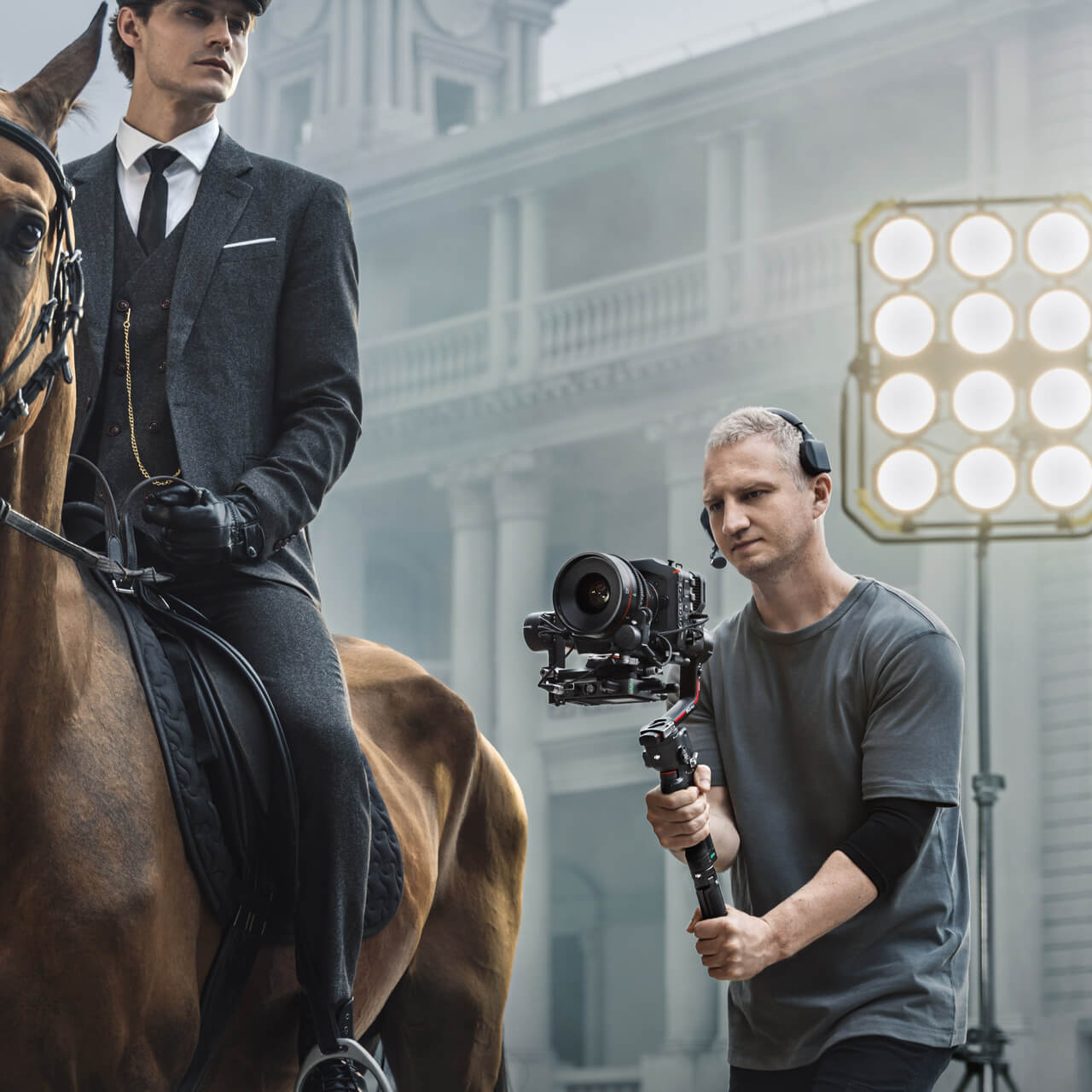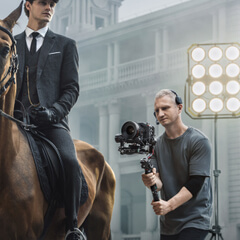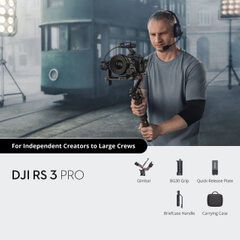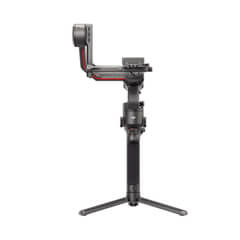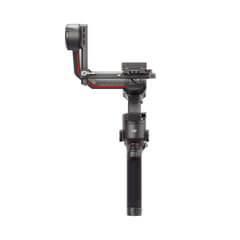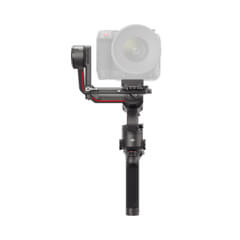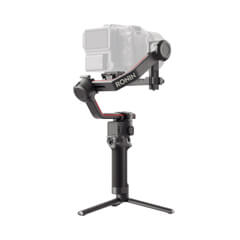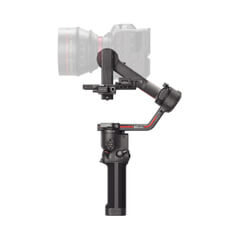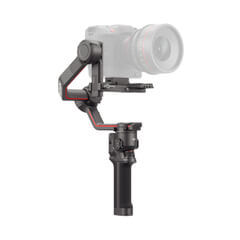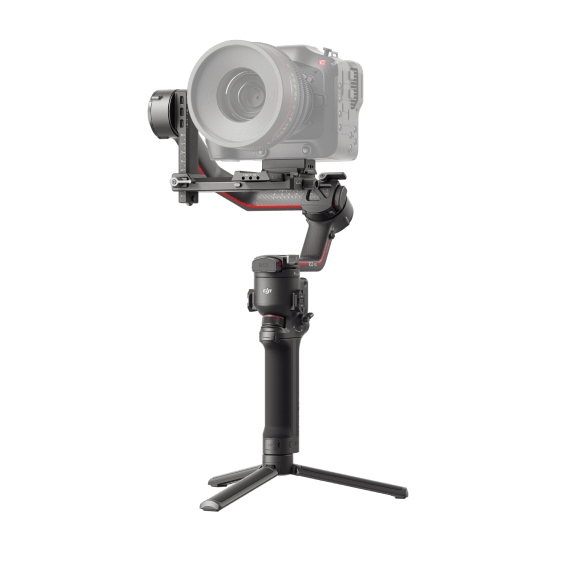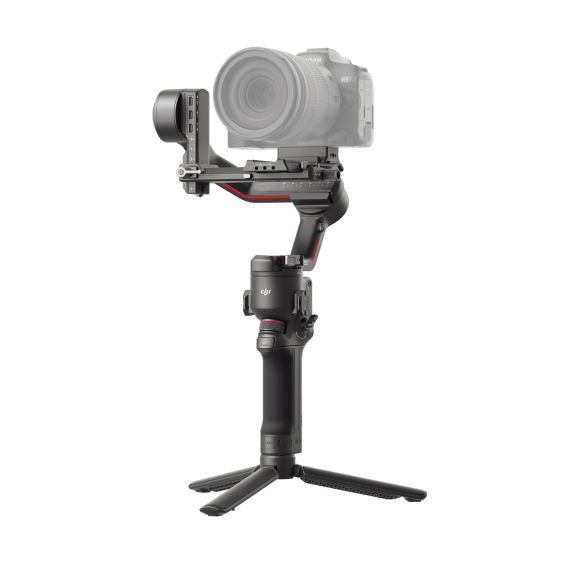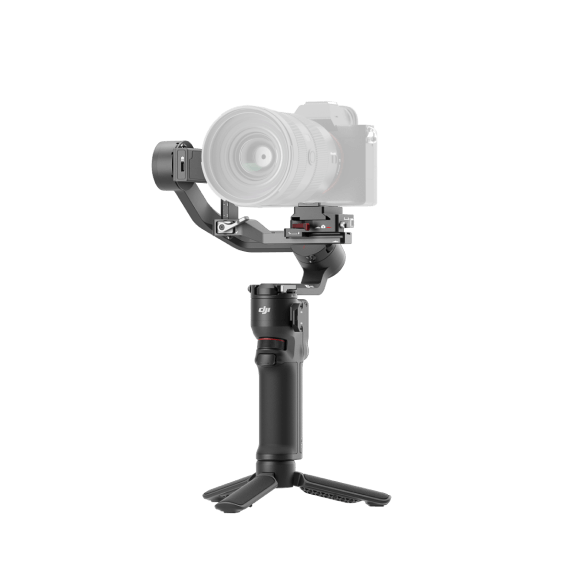DJI RS 3 Pro
Select Option
Need help choosing? Talk to a DJI expert.
Take a Closer Look
Automated Axis Locks Get You Ready Instantly
Automated Axis Locks get the gimbal ready to work or sleep instantly, making company move and gear storage significantly more efficient.
Advanced LiDAR Focusing [2]
The LiDAR focusing system makes focusing easier and enables autofocus on manual lenses when paired with the focus motor. [3] It also supports ActiveTrack Pro for advanced tracking.
4.5kg (10lbs) Tested Payload
With a larger balancing space, RS 3 Pro remains just 1.5 kg/3.3 lbs, [1] while its load capacity is 4.5 kg/10 lbs to meet various shooting needs.
Increased Payload Capability, Stiffer Gimbal
Extended Carbon Fiber Axis Arms allow more balancing space and are constructed from layered sheets of uncut carbon fiber to improve stiffness and reduce weight.
Long-Range O3 Pro Video Transmission [2]
Supports 6km/20,000ft [4] video and audio transmission with ultra-low latency, impressive stability, and extensive coordinated control features.
In the Box
Carrying Case
× 1
Gimbal
× 1
BG30 Grip
× 1
USB-C Charging Cable (40 cm)
× 1
Lens-Fastening Support (Extended)
× 1
Extended Grip/Tripod (Metal)
× 1
Quick-Release Plate (Arca-Swiss/Manfrotto)
× 1
Briefcase Handle
× 1
Multi-Camera Control Cable (USB-C, 30 cm)
× 1
Screw Kit
× 1
Which is the Best for You?
Let’s Answer Your Questions
How is DJI RS 3 Pro upgraded compared with DJI RS 2?
DJI RS 3 Pro features new designs like extended carbon fiber axis arms, automated axis locks, and Bluetooth shutter, bringing more balancing space and greater control efficiency. It is also equipped with the latest generation of DJI RS stabilization algorithms that provides significantly enhanced stability. Additionally, it supports LiDAR focusing and O3 Pro video transmission technologies to provide integrated receiving, monitoring, and control. In general, RS 3 Pro can meet more professional creative needs.
What are the differences between a standalone DJI RS 3 Pro and the DJI RS 3 Pro Combo? What other accessories are worth buying besides those included in the combo?
A standalone DJI RS 3 Pro is more than enough to meet basic shooting needs. The DJI RS 3 Pro Combo additionally includes accessories such as the DJI Ronin Image Transmitter, DJI RS Focus Motor (2022), Focus Motor Rod Mount Kit Combo, DJI R Focus Gear Strip, Lower Quick-Release Plate (Extended), and the DJI R Phone Holder to support more professional focusing and remote monitoring and control. In addition, DJI RS 3 Pro can work with the DJI LiDAR Range Finder (RS) and DJI Transmission to achieve autofocus on manual lenses, ActiveTrack Pro, O3 Pro video transmission, and coordinated control.
For more comparisons between the standalone gimbal and the combo, read DJI RS 3 Pro Unboxing.
What are the differences between DJI RS 3 and DJI RS 3 Pro? Which one should I choose?
DJI RS 3 is designed for small crews and solo creators. It can carry mirrorless cameras and DSLRs, and features efficient control, flexible parameter adjustments, and a lightweight body with significantly enhanced stabilization capability. It is especially useful for shooting weddings, events, real estate, and corporate promotional videos. DJI RS 3 Pro is designed for medium-to-large crews. It is compatible with mainstream DSLRs and mirrorless cameras. It has better load capacity, focusing, coordinated shooting, and expansion capabilities than RS 3, with the same efficient designs and stabilization performance. It offers a wealth of possibilities for shooting TVCs, MVs, documentaries, reality shows, and more.
What material is DJI RS 3 Pro made of?
DJI RS 3 Pro is primarily composed of aluminum alloy and carbon fiber.
How do I use the automated axis locks on DJI RS 3 Pro?
When the gimbal is powered off, press and hold the power button, and the three axes unlock and expand automatically for use within just a few seconds. Press and hold the power button again to lock the axes and power off the gimbal. During use, press the power button once, and the axes automatically lock and enter sleep mode. Press once again to unlock and wake.
What are the differences between SuperSmooth and the normal stabilization of DJI RS 3 Pro?
SuperSmooth mode was developed for fast-moving scenarios. It increases the torque of DJI RS 3 Pro to further enhance stabilization, delivering stable footage in more dynamic and strenuous shooting scenarios.
How do I enable different gimbal modes for DJI RS 3 Pro?
With the new gimbal mode switch, you can quickly change between Pan Follow, Pan and Tilt Follow, and FPV modes. The FPV switch is also customizable to 3D Roll 360, Portrait, or Custom.
How long is the runtime of the DJI RS 3 Pro battery grip? How long does it take to fully charge the DJI RS 3 battery grip? Can it be used while charging?
The battery grip has a maximum runtime of 12 hours* and a charge time of 1.5 hours.** It can be used while charging.
* Measured with the equipment in a level and stationary state, the gimbal balanced, three axes in an active state, and the battery only powering the gimbal.
** Measured with an 24W charger. It is recommended to use QC 2.0 or PD protocol chargers.
Which cameras and lenses are supported by DJI RS 3 Pro?
Please refer to the Ronin Series Compatibility Search.
What cameras can be controlled by the Bluetooth shutter of DJI RS 3 Pro?
Please refer to the Ronin Series Compatibility Search.
What accessories can be used interchangeably among DJI RS 3 Pro, DJI RS 3, DJI RS 2, and DJI RSC 2?
Please check the appendix: DJI RS Series Universal Accessories List
Still have questions? Get help from a DJI expert.
1. Includes gimbal, battery grip, and dual-layered quick-release plates.
2. Requires purchase of additional accessories.
3. Included in the DJI RS 3 Pro Combo, and also sold separately.
4. Measured in Control mode with FCC compliance in a standard, interference-free environment.
